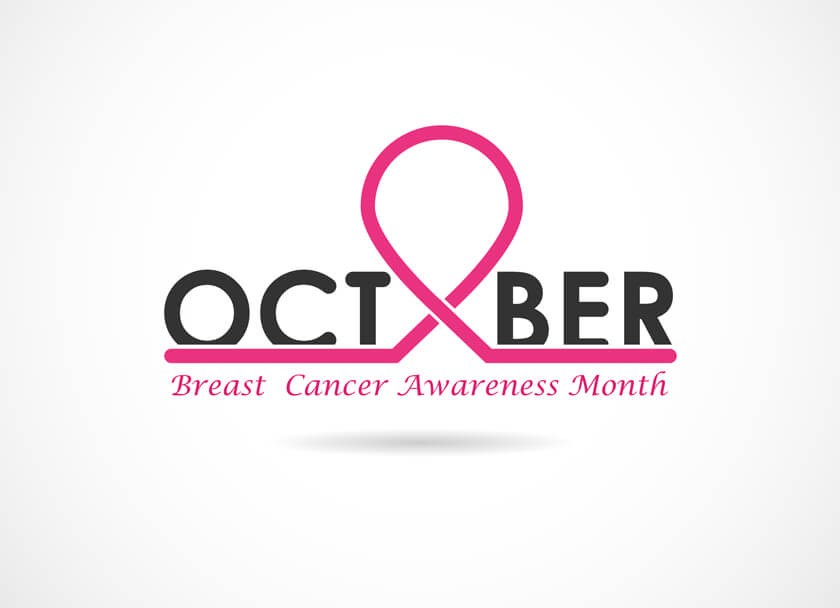
October is National Breast Cancer Awareness Month

October is National Breast Cancer Awareness Month, an annual event that increases awareness of the disease and promotes the early detection of breast cancer through mammography.
National Breast Cancer Awareness Month began in 1985 when the American Academy of Family Physicians, AstraZeneca Healthcare Foundation and several other sponsors collaborated to raise awareness of breast cancer and to gain funding to help researchers find a cure.
Today, national public service organizations, government agencies, and professional medical associations participate in Breast Cancer Awareness Month by encouraging women to perform self-breast examinations regularly, undergo mammograms as recommended, see their doctors regularly, and learn about breast health and breast cancer.
Breast cancer is characterized by an uncontrolled growth of breast cells. Cancer occurs as the result of abnormal changes in the genes responsible for regulating the growth and health of cells. New body cells normally divide to replace dying cells in an orderly and controlled process of cell growth; instructions in genes tell the cells when to divide, how fast they should grow, and when to die. Changes in genes can alter the instructions, telling cells to keep dividing without control or order. This fast production of unhealthy, fast-growing cells in breast tissue produces a tumor.
Health care professionals refer to a tumor as malignant or benign. Benign tumors are not dangerous; they grow slowly and do not spread to other parts of the body. Malignant tumors, on the other hand, can be dangerous because they grow quickly and can spread.
Breast cancer is the second most common type of cancer in women in the United States, according to the Centers for Disease Control and Prevention (CDC). According to the most recent statistics presented by the CDC, doctors diagnosed 236,968 women and 2,141 men in the U.S. with breast cancer in 2014. That year, breast cancer claimed the lives of 41,211 American women and 465 men.
Breast Cancer Screening During Breast Cancer Awareness Month
Breast self-examination, in which a woman looks at and feels her breasts for lumps or other problems, is one way to detect early breast cancer. Clinical examinations from a doctor or practitioner are also helpful.
Regular mammograms can lower the risk of death from breast cancer. The American Cancer Society recommends yearly mammograms for females age 45 to 54; women ages 40 to 44 who are at average risk for breast cancer may choose to have mammograms. Women who are 55 and older may switch to mammograms every two years or continue with yearly screening. Mammograms should continue as long as a woman is in good health and is likely to live at least another 10 years.
A small number of women – those with a family history, genetic tendency or certain other factors – should have screening with MRIs along with mammograms.
Mammograms
A mammogram is an x-ray image of the breast. A health care provider uses a mammogram to look for early signs of breast cancer. A mammogram can detect early signs of breast cancer up to three years before it can be felt.
Full-field Digital Mammography
Full-field digital mammography (FFDM) is a special technique that digitizes the images for viewing on a computer rather than on x-ray film. Digital x-rays produce highly detailed images while using less radiation. The digital images are also easier to share during consultations.
3D Mammography
3D mammography creates highly detailed images of breast tissue. Doctors often perform 3D mammography, also known as digital breast tomosynthesis, along with and immediately after 2D imaging. During a 3D mammogram, a special x-ray arm sweeps over the breast and emits x-rays as it goes to create a series of images. Each image shows a thin slice of breast tissue. Health care providers can then examine each image as an individual picture, view the entire series as a dynamic interactive animation, or use special software to produce three-dimensional images of the interior of the breast.
Being able to “flip through” individual images of breast tissue makes it easier for health care providers to spot fine details that might otherwise by hidden behind overlapping breast tissue. Increased accuracy also decreases the chances a patient will have to return for additional imaging, an advantage that reduces patient anxiety associated with repeat testing.
Research shows that a 3D mammogram can significantly improve breast cancer detection, especially in the earliest stages of cancer.
Breast Cancer Awareness Month is a great time for women to talk about their risk for breast cancer with their health care providers, and to work with their doctors to develop a personal screening plan.




